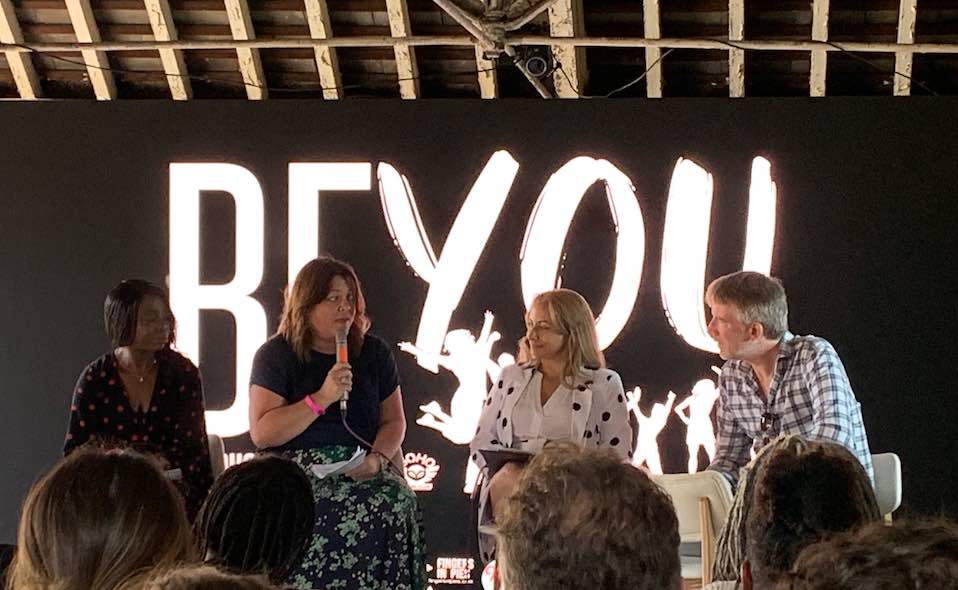To make systemic change, the TV industry needs to brace itself for new realities and take account of the range of under-represented groups, keeping intersectionality front of mind.
Speaking at last week’s Be You Festival in Soho, panelists Jasmine Dotiwala, TV producer, director, and reporter, Hayley Payne head of Human Resources for Banijay UK and Joyce Adeluwoye-Adams MBE, editor, Newsroom Diversity at Reuters looked at how to create a holistic approach for inclusion and belonging.
The panel, chaired by James Bennett, md of Televisual, explored how the speakers were seeking to make diversity a part of their DNA and harness a culture of belonging.
The panel agreed that there was no one broad brush. Intersectionality meant looking at each person separately, taking into account that there are many people who are from more than one under-represented group.
To make a difference meant getting the workforce, at all levels, to talk about change and be prepared to listen, understand and allow for new ways of working. Ensuring that the workforce is diverse has long been proven to be commercially positive and a great force for cultural good.
Jasmine Dotiwala on what you can do towards inclusivity
How to manage change:
1. It’s about Being clear about the vision behind the change -identify the intent.
2. Give your teams the floor to share fears and ideas.
3. Share an action plan with next steps, once everyone agrees on what’s best for your company and the next steps.
4. Manage any resistance with kindness and understanding.
5. Make time for recognition when things have worked and credit the people who created the change
6. Give managers and leaders the autonomy to create their own DEI objectives and then input incentives-both financial and awards- to ensure recognition!7. Any conversations and DEI and change will initially feel awkward and taboo- so manage your teams expectations and tell them to enjoy feeling discomfort
7. Get your teams comfortable saying phrases in the diversion, inclusion, equity landscape, like ‘’working class’’ ‘’black’’ ‘’disabled’’ ‘’trans’’8. Set timeline and leaders inclusion targets should be tied to their salaries.
Making content more inclusive
Look at the success of titles like Black Panther, Bling Empire, Ms Marvel, Crazy Rich Asians. Can you imagine the amount of money and viewer ratings we’ve left on the table over the years, because we haven’t had an inclusive mindset?
1. Do staff feel like they belong? For example, give people their cultural festival days off and acknowledge them internally and externally
2. Ask all your teams to take and share team photos- do all the people look the same-or is there a diversity deficit?
3. Change recruitment process panels, pipelines, communications, outreach
4. Encourage 2-way feedback-you’ll be shocked what answers you get when people are asked ‘’what do we never talk about that we should talk about more?”
5. Encourage your teams to challenge thought, ideas, decisions and injustice. If they know theres a safe space to do so, they won’t be resentful and they will be more productive.
6. Onboard young new talent professionally
7. Create new face to face comms between C Suite and talent. Examples are staff-breakfast brainstorms, lunch and learn, park picnic pitches.
8. Make any action and inclusion programmes – speedy – don’t get bogged down in long, laborious process which people forget and grow weary about
9. Keep DEI inclusion reading material available for staff-better still gift them goodie bags
10. Ensure Employee Resource Groups exist for every underrepresented group+ invite allys to attend and listen to experiences
11. Create Safe spaces for taboo conversations around inclusion
12. Ask People from young, new or URG to join and be included and asked to contribute at the C Suite / the Board tables.
14. Show all your DEI staff impact and celebrate it loudly.
15. Use agencies and third sector organisations that promote diverse creators, storytellers, and both on- and off-screen talent. ……Across London and beyond, there are hundreds of young media groups churning out incredible 360 multimedia talent- Media Trust, Fully Focused, Arts Emergency, Mama Youth, The Roundhouse, Livity and so many more
16. Introduce content and/or commissioning guidelines to help content creators incorporate DEI during concept development, filming, and/or asset creation:
17. Train your content team and agencies to be aware of stereotypes and intentionally manage positive portrayals of all people. ….see the Unstereotype guide
18. Consider auditing your marketing assets, advertising material, and other media content to understand who is and isn’t represented in your content.
19. Make use of incredible inclusion pieces that already exist.
20. Whilst every company should eventually have its own culture doc and values clearly on websites and filtered down to all staff. If you don’t have the capacity for that at first, don’t worry. There are already numerous resources at orgs like the film & tv charity and Screenskills and the Amazon Inclusion Playbook.Bad Practice
• Don’t make people leave their identity at the door
• Don’t overlook and forget staff and talent from URG’s for awards and accolades
• Invite diverse staff and talent to join you at VIP external functions
• Don’t create long signup and accessibility processes for progression
• Under Represented Group’s like Black, Asian, and disabled staff may not voice it- but we already feel more vulnerable- so take any bullying claims seriouslyDO these things and do them swiftly – I wish for you many uncomfortable conversations!
Pippa Considine
Share this story

















